(adapted from Fundamentals of Tabla)
| ATTENTION |
|---|
| A much better overview of this material is the book / Streaming Audio set entitled “Learning the Tabla – 1” and “Learning the Tabla – 2” |
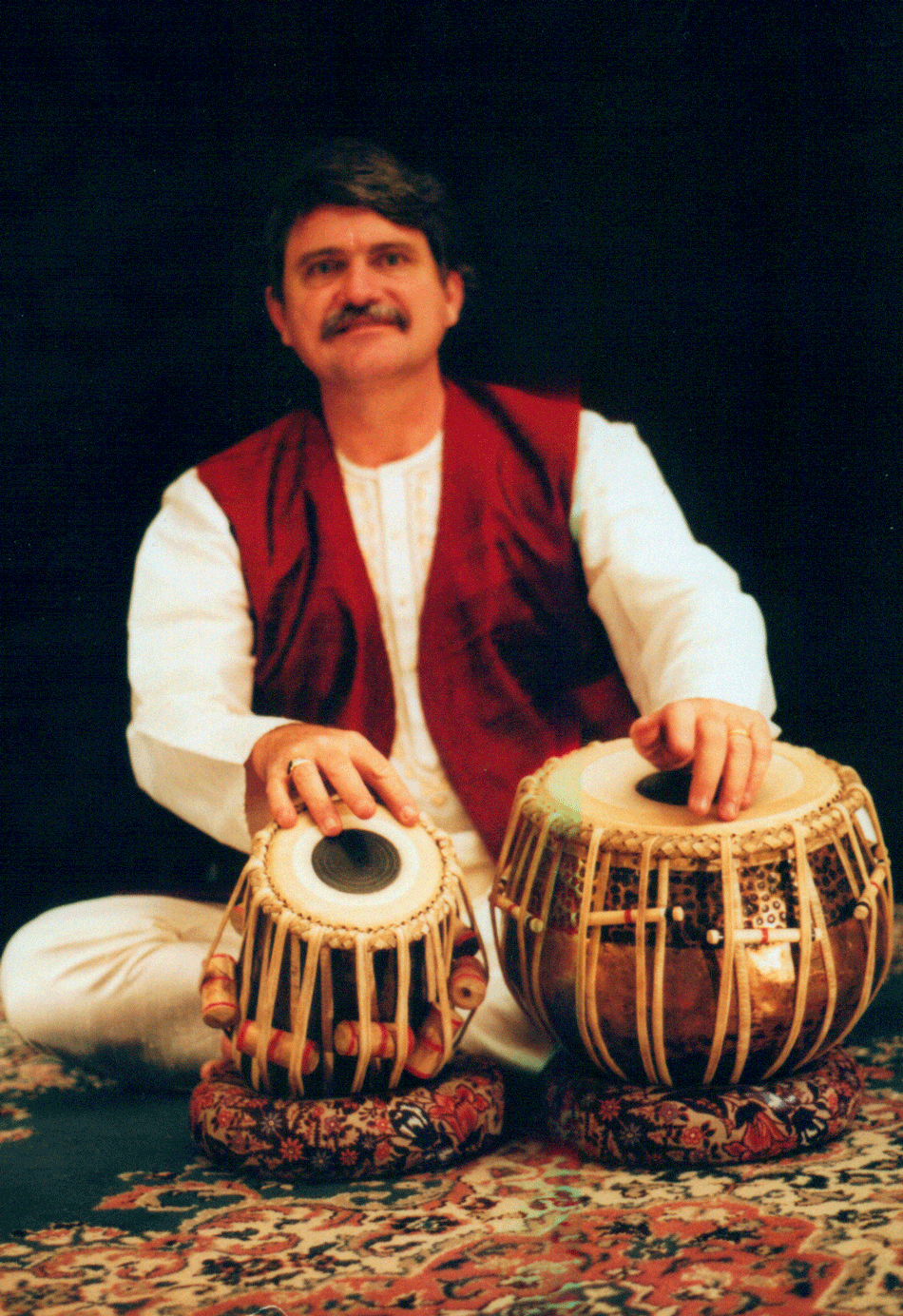
Dhaa | Dhin | Ga | Ka | Kat | Naa | Na | Taa| Tak | Tee | TiRaKiTa | TiTa | Tin | Too
This is a list of the basic strokes with their techniques. Please note that the Roman script is very weak. In particular the English “D” and “T” are very ambiguous. Please note too that many different bols are written the same in English. Use the Devnagri script to help clarify the pronunciation.
The techniques which are described here are for right handed people. A left handed person should simply reverse the drums and exchange the terms left and right.
There are many more bols than are practical to give in this web site. There are also many more issues which are not easily handled here. For a more extensive discussion please refer to “Fundamentals of Tabla”.
You may want to refer back to this illustration in order to understand the terminology used for location:
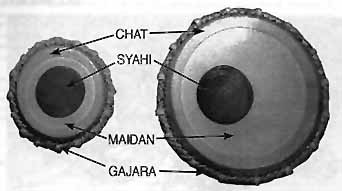
Dhaa | Dhin | Ga | Ka | Kat | Naa | Na | Taa| Tak | Tee | TiRaKiTa | TiTa | Tin | Too
Dhaa
– (Pronounced as in “Ad hoc”) This is a bol that uses both hands. It is a combination of Taa and Ga. There are at least four ways to play this bol; however the two most common versions are the Delhi (Dilli) style and the Purbi style. Both styles are illustrated here. See Ga and Taa for details of their techniques.

Delhi (Dilli) Style
This is nothing more than the simultaneous playing of Taa and Tin in the Dilli style.
Purbi Style
The Purbi style of Dhaa is very reminiscent of the Delhi approach to Dhin. The distinction is easy to make if one remembers that the Purbi Dhaa has the right hand struck very loudly, while the right hand of the Delhi style Dhin is barely audible.
Dhaa | Dhin | Ga | Ka | Kat | Naa | Na | Taa| Tak | Tee | TiRaKiTa | TiTa | Tin | Too
Dhin
– (Pronounced as in “and hinder”) Dhin is a simultaneous playing of Ga and Tin. There are at least four different ways to play Dhin. One common version is illustrated here. See Ga and Tin for details of their technique.

Dhaa | Dhin | Ga | Ka | Kat | Naa | Na | Taa| Tak | Tee | TiRaKiTa | TiTa | Tin | Too
Ga
– (Pronounced as in “Gum”) This is a resonant stroke of the left hand. There are numerous variations on the technique. The three most common techniques are the two finger, index finger, and open hand. With the exception of the open hand Ga, all are subject to a wide array of modulations. It also has a variety of pronunciations. Common ones are Ge, Gha, Ghe, Gin, or Ghin.

Two Finger Ga
The two finger Ga is the most common form. The most common technique is to hold the wrist down and arch the fingers over the syahi. The middle and ring-fingers then strike the maidan (the exposed skin between the syahi and the chat.) One must always remember that this stroke is “khula” or an open stroke, therefore it must be very resonant.
Ga may be difficult for the beginner. There is a tendency to strike the drum and withdraw the hand under conscious control. Such action cannot be performed consciously. It is essential that the fingers and hand be relaxed the instant the drum is struck so that the hand can rebound of its own accord; like a ricochet. Only then can you hear the full open sound that characterizes this stroke.
Some players use only the middle finger. This is generally considered to be a very poor technique.
Index Finger Ga
This is another common technique. Although it is a bit weaker than our standard two finger technique, when used in conjunction with the two-finger Ga, one is able to attain high speeds.
Open Hand Ga
This Ga is played with the full open hand. This is generally used for special effects such as one might find in a Kathak recital.
Dhaa | Dhin | Ga | Ka | Kat | Naa | Na | Taa| Tak | Tee | TiRaKiTa | TiTa | Tin | Too
Ka
– (Pronounced as in “Cup”) This is a very common nonresonant stroke of the left hand. It is also the easiest to execute. One simply strikes the bayan with the flat palm and fingers. Notice that the tips of the fingers extend slightly over the rim of the bayan. It is a flat slapping sound with no resonance, therefore it is called “band“. The most common version is shown in the illustration, however other forms exist. (see “Fundamentals of Tabla” for other variations.)

Dhaa | Dhin | Ga | Ka | Kat | Naa | Na | Taa| Tak | Tee | TiRaKiTa | TiTa | Tin | Too
Kat
![]() – (Pronounced as in “Cut”) Kat is a common variant of Ka. Its technique is basically the same, except the left hand is kept further back. This allows it to be louder than the more usual Ka.
– (Pronounced as in “Cut”) Kat is a common variant of Ka. Its technique is basically the same, except the left hand is kept further back. This allows it to be louder than the more usual Ka.

Dhaa | Dhin | Ga | Ka | Kat | Naa | Na | Taa| Tak | Tee | TiRaKiTa | TiTa | Tin | Too
Naa
– (Pronounced as in “Not” ) This is a common resonant stroke of the right hand. It is produced by holding the last two fingers lightly against the syahi and using the index finger to forcefully hit the rim (chat or kinar) of the tabla. It is important to keep the middle finger extended so as not to hit the drum.
The correct position may be visualized by an “X” running across the drum. This cross pattern is not imaginary but is a reflection of actual resonance characteristics. The position of this cross is determined by the ring finger and little finger. Sliding these fingers around will cause the position of the cross to vary. Maximum efficiency is produced when one strikes the chat at the position where the other leg of the cross passes over the rim. This is shown in the accompanying illustration.

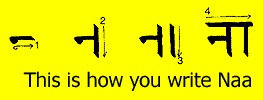
There are several versions of this stroke. They are differentiated by the exact place of striking and whether the finger is allowed to rebound or not. Occasionally one may find this stroke executed by muting with all of the last three fingers of the right hand; this however is considered to be very poor technique.
Dhaa | Dhin | Ga | Ka | Kat | Naa | Na | Taa| Tak | Tee | TiRaKiTa | TiTa | Tin | Too
Na
– (Pronounced as in “Nut”) This is a nonresonant stroke which is made by striking the edge of the syahi with the last two fingers of the right hand. This stroke has numerous names, especially when used as part of larger bol expressions. Some common ones are Da, Ra and Ta.

Dhaa | Dhin | Ga | Ka | Kat | Naa | Na | Taa| Tak | Tee | TiRaKiTa | TiTa | Tin | Too
Taa
– (Pronounced as in Taco) This is a common stroke of the right hand. There are at least four ways to play this bol. However only two are common: the Dilli (Delhi) approach and the Purbi approach. We will also discuss a less common form found in Kathak performances.
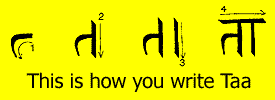
Delhi (Dilli) Style Taa
The Dilli (Delhi) style is to play it exactly like Naa (i.e. striking sharply with the index finger against the rim). See Naa for further information on this technique.
Purbi Style Taa
The Purbi approach is to place the last two fingers lightly against the syahi and then strike sharply in the maidan with the index finger. This is very similar to Tin; unlike Tin, it is played more forcefully.
A variation is found among members of the Lucknow gharana, who quickly remove the hand from the drum as soon as it is struck. Most musicians feel that such technique yields an uncontrolled sound and thus reject this.
Pakhawaj Style Taa
This style is derived from the pakhawaj. It is very loud, and thus inappropriate for most accompaniment situations. However it is commonly used in the accompaniment of kathak dancers.
Dhaa | Dhin | Ga | Ka | Kat | Naa | Na | Taa| Tak | Tee | TiRaKiTa | TiTa | Tin | Too
Tak
Tak is a non-resonant stroke of the right hand. In some uncommon situations, this stroke may be called Kat. It is made by gently cupping the right hand and bringing it down against the centre of the drum.

Dhaa | Dhin | Ga | Ka | Kat | Naa | Na | Taa| Tak | Tee | TiRaKiTa | TiTa | Tin | Too
Tee
– (Pronounced as in “Team”) There are several approaches to this stroke. One very common way is to strike the centre of the syahi with the middle finger of the right hand. This is shown in the accompanying illustration. However many times Ti is considered to be synonymous with Tin. Please refer to Tin for this technique.

Dhaa | Dhin | Ga | Ka | Kat | Naa | Na | Taa| Tak | Tee | TiRaKiTa | TiTa | Tin | Too
Ti Ra Ki Ta
– This bol is composed of four strokes. There are very many techniques, but here we will only discuss two forms; the modern Dilli (Delhi) and the Purbi styles. Today it is very usual to mix Dilli and Purbi techniques. It is common to mix them even within the same composition. Such mixing is done in order to get a balance of speed and clarity.

The Delhi (Dilli) Style
The Delhi style is characterized by an independent use of the middle finger. Ti is played by striking the centre of the syahi with the middle finger of the right hand. Ra is played by striking the centre of the syahi with the index finger of the right hand. Ki is played by striking the left hand sharply against the head (like Ka). Ta is played by striking the edge of the syahi with the last two fingers of the right hand. All of these strokes are nonresonant (i.e. bandh).
One should keep in mind that there is an older form which does not use the ring finger/little finger. However we will not discuss that here.
The Purbi Style
The Purbi approach is a different. We lead off with the last three fingers of the right hand (i.e.middle, ring, and little fingers); this would be the Ti. Ra is played by striking the centre of the syahi with the index finger. Ki is a standard left hand Ka, and the final Ta would be played with the last three fingers.
Dhaa | Dhin | Ga | Ka | Kat | Naa | Na | Taa| Tak | Tee | TiRaKiTa | TiTa | Tin | Too
Ti Ta
– This bol is made of two strokes. There are at least five techniques for executing this stroke, but we shall describe only three here: the Dilli (Delhi), Purbi, and the reverse Purbi. There are several variations in the bol. It is also common to find this expression called TeTe, TeTa or in some cases even KiTa.
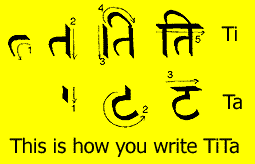
Delhi (Dilli) Style Ti Ta
The basic Dilli (Delhi) style is simple. Ti is made by striking the centre of the syahi with the middle finger. This is a non-resonant (band) stroke. Ta is made by striking the centre of the syahi with the index finger. This too is a non-resonant (bandh) stroke and should have a sound that is indistinguishable from Ti.
Purbi Style Ti Ta
The Purbi style is a little bit different. Ti is executed by striking sharply with the last three fingers of the right hand. (i.e. middle, ring, and little fingers). Ta is executed by striking the centre of the syahi with the index finger.
Reverse Purbi Style Ti Ta
The reverse Purbi Ti Ta is the same as the standard version, except one starts the index finger of the right hand, then follows with the last three fingers. This gives a speed advantage in many situations because it leaves the hand very near the home position. This makes the execution of a subsequent Dhaa, Dhin or a host of other strokes much easier and faster.
Dhaa | Dhin | Ga | Ka | Kat | Naa | Na | Taa| Tak | Tee | TiRaKiTa | TiTa | Tin | Too
Tin
– ( Pronounced as in “Tin can”) This is a resonant stroke of the right hand. Its hand position is very similar to Naa, but it is much softer and more delicate. This stroke is produced by placing the last two fingers of the right hand lightly against the syahi and striking on the border between the syahi and the maidan. As with Naa, the middle finger is extended and does not strike the drum. Great care must be taken so that the stroke is resonant. This resonance will only come if it is a light ricochet. The exact striking position is determined by the construction of the drum but it is usually at the border of the syahi and maidan. Beginners often have a difficult time making Tin sound different from Naa. There are two points to keep in mind. First, the stroke must be resonant. Second, it must be played very softly.

Dhaa | Dhin | Ga | Ka | Kat | Naa | Na | Taa| Tak | Tee | TiRaKiTa | TiTa | Tin | Too
Too
– (Pronounced “Two”) This is a resonant stroke of the right hand. The head is not muted at all but allowed to resonate freely. The head is struck in the centre of the syahi with the index finger of the right hand. There are several variations in pronunciation. Some common examples are Tun, Thu, Thun, etc.

Dhaa | Dhin | Ga | Ka | Kat | Naa | Na | Taa| Tak | Tee | TiRaKiTa | TiTa | Tin | Too
